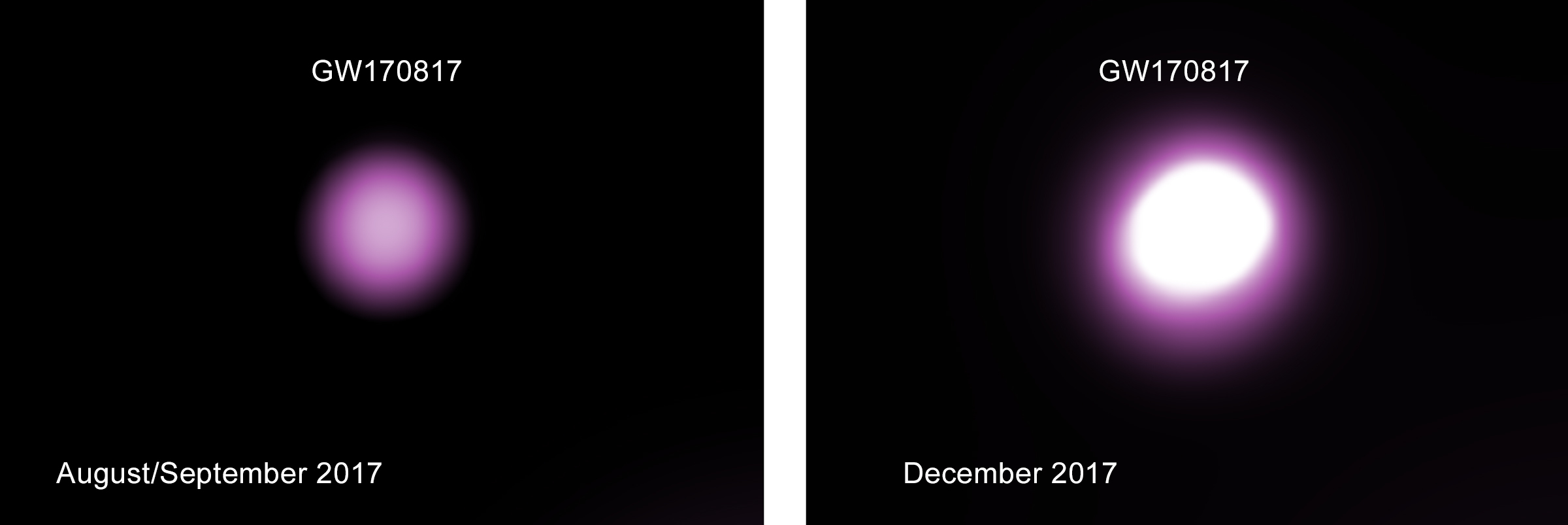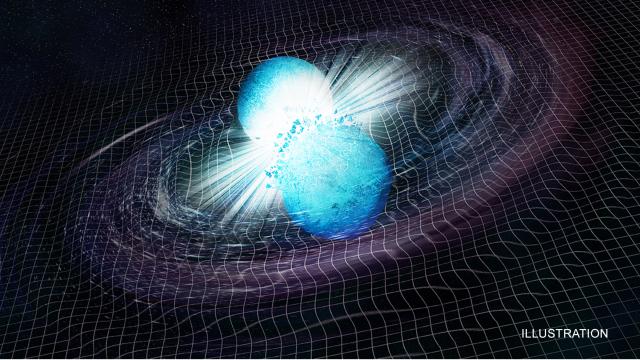On August 17, 2017, astronomers witnessed an extraordinary celestial event: a collision between two ultra-dense neutron stars. Scientists had never seen anything quite like it, leading to much speculation as to what happened in the wake of the monumental encounter. New research now suggests the collision produced a black hole — but if true, it would be the lightest black hole known to science.
Artist’s depiction of the neutron star mergerIllustration: Illustration: CXC/M. Weiss; X-ray: NASA/CXC/Trinity University/D. Pooley et al.
The thought of two neutron stars smashing into each other is nothing short of astounding. Neutron stars are stellar corpses — the remnants supernovae — and they cram a huge amount of mass into a ludicrously small sphere. Typical neutron stars are only as wide as a large city, but they’re about a half million times more massive than Earth, or about two solar masses.
A collision of two neutron stars may seem unlikely, but it happened. Data from the Laser Interferometer Gravitational Wave Observatory (LIGO) and the Virgo interferometer showed that shit got completely wild in the moments leading up to the colossal smash up. For a period of about two minutes, the binary pair spiraled around each other with unimaginable speed, spewing gravitational waves into the cosmic void.
Each orbit brought the pair closer together, culminating in a collision that produced a giant shockwave.
Astronomers had seen pairs of black holes perform the same celestial dance, but two neutron stars coming together was completely new. The end product of the merger has been a bit of a mystery, but new research published this week in Astrophysical Journal Letters suggests the collision generated a tiny black hole.

After two stars underwent supernova explosions, two neutron stars were left behind. New research suggests gravitational wave radiation pulled them together until they merged and collapsed into a black hole.Image: CXC/M. Weiss; X-ray: NASA/CXC/Trinity University/D. Pooley et al.
Using NASA’s Chandra X-ray Observatory, researchers from the University of Texas at Austin and the University of California, Berkeley, sought to understand what happened during and after the merger. LIGO data suggested the new object, dubbed GW170817, had a mass about 2.7 times that of our Sun.
That’s a rather curious finding, because it doesn’t quite fit into what we know of neutron stars or black holes. If it’s a neutron star, GW170817 would be the most massive object of its kind known to science; the largest known neutron stars are between 2.3 to 2.4 solar masses — these objects are already testing the limits of how much material can be packed into a small space before collapsing into a black hole. But if it’s a black hole, it would be the least massive black hole ever detected, as the tiniest black holes are between four and five solar masses.
Now here’s the cool thing about neutron stars: They’re also pulsars. These rapidly spinning, high-density objects generate powerful magnetic fields and a bubble of high-energy particles. On Earth, we should see this as a distinctive, strong X-ray signature. Using Chandra, the authors of the new study measured X-rays coming from GW170817 in the days, weeks and months following the merger.
As the new study shows, this object’s X-ray emissions were way lower than what would be expected from a super-massive, rapidly spinning neutron star — like, several hundred times lower. Hence the study’s conclusion that the merger produced a black hole, albeit a very small one.
“We may have answered one of the most basic questions about this dazzling event: what did it make?” Pawan Kumar, a co-author of the new study and an astronomer at the University of Texas at Austin, said in a statement. “Astronomers have long suspected that neutron star mergers would form a black hole…but we lacked a strong case for it until now.”
If confirmed, it points to a rather complex process of black hole formation. In this case, there had to be a pair of supernova explosions, the remnants of which formed neutron stars, which happened to be close enough to eventually come together. But this isn’t as outlandish as it may seem. Upwards of 80 per cent of massive stars, like O and B-type stars, come in binary pairs.
And because stars are typically born together, they often die together, or at least within short periods of cosmological time. So it shouldn’t be a surprise that binary neutron stars are a thing, and that sometimes they come together to produce black holes.
If a black hole is indeed what this object is. The title of the new study, “GW170817 Most Likely Made a Black Hole,” points at that uncertainty. Indeed, followup observations will be required to make a definitive case. If GW170817 is a black hole, astronomers should expect to see X-ray emissions get progressively fainter. If it’s a neutron star, it should start to get brighter in both X-rays and radio wavelengths as its bubble of high-energy particles catches up to the decelerating X-ray shock wave. Either way, we should know in the next few years.
Regardless, it will be an exciting result. Gravitational wave science is truly changing what astronomers are able to see.
“At the beginning of my career, astronomers could only observe neutron stars and black holes in our own galaxy, and now we are observing these exotic stars across the cosmos,” said co-author Bruce Gossan of the University of California at Berkeley. “What an exciting time to be alive, to see instruments like LIGO and Chandra showing us so many thrilling things nature has to offer.”
